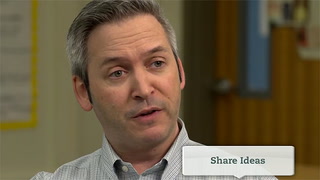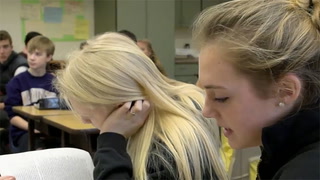Series Evidence & Arguments: Evidence & Arguments: Lesson Planning
ELA.RI.9-10.2
| Common core State Standards
- ELA: English Language Arts
- RI: Reading Standards for Informational Text 6-\x80\x9312
- 9-10: 9th & 10th Grades
-
2:
Determine a central idea of a text and analyze its development over the course
of the text, including how it emerges and is shaped and refined by specific
details; provide an objective summary of the text.
ELA.W.9-10.6
| Common core State Standards
- ELA: English Language Arts
- W: Writing Standards 6-12
- 9-10: 9th & 10th Grades
-
6:
Use technology, including the Internet, to produce, publish, and update
individual or shared writing products, taking advantage of technology'\x80\x99s
capacity to link to other information and to display information flexibly and
dynamically.
ELA.SL.9-10.1a
Common core State Standards
- ELA: English Language Arts
- SL: Speaking and Listening Standards 6-\x80\x9312
- 9-10: 9th & 10th Grades
-
1a:
Initiate and participate effectively in a range of collaborative discussions
(one-on-one, in groups, and teacher-led) with diverse partners on grades 9-\x80\x9310
topics, texts, and issues, building on others'\x80\x99 ideas and expressing their own
clearly and persuasively.
a. Come to discussions prepared, having read and researched material under
study; explicitly draw on that preparation by referring to evidence from
texts and other research on the topic or issue to stimulate a thoughtful,
well-reasoned exchange of ideas.
b. Work with peers to set rules for collegial discussions and decision-making
(e.g., informal consensus, taking votes on key issues, presentation of
alternate views), clear goals and deadlines, and individual roles as needed.
c. Propel conversations by posing and responding to questions that relate the
current discussion to broader themes or larger ideas; actively incorporate
others into the discussion; and clarify, verify, or challenge ideas and
conclusions.
d. Respond thoughtfully to diverse perspectives, summarize points of
agreement and disagreement, and, when warranted, qualify or justify their
own views and understanding and make new connections in light of the
evidence and reasoning presented.
Save to My Resources
PLEASE CREATE A NEW ACCOUNT OR LOG IN TO ACCESS THIS CONTENT
Enjoy your first video for free. Subscribe for unlimited access.
Have questions about subscribing?
Click Here to learn more about individual subscriptions.
Click Here to learn more about School and Institution access.
Discussion and Supporting Materials
Thought starters
- How does Mr. Hanify integrate the different Common Core standards into this lesson?
- Notice the varied opportunities for student discussion throughout the lesson. How does Mr. Hanify design activities that scaffold student learning?
School Details
International School445 128th Avenue Southeast
Bellevue WA 98005
Population: 573
Data Provided By:

Teachers
T.J. Hanify
Newest
|
4 MIN
|
5 MIN
|
5 MIN
UNCUT CLASSROOMS
| TCHERS' VOICE
English Language Arts











82 Comments
Michael Daigre Sep 9, 2023 9:34pm
Mr. Hanify uses several different Common Core standards, including reading, speaking & listening, and writing to plan his class. This allows him to meet several standards and simplify readings within his course. He also explains how using different design activites to make "complex reading" simple so the students can understand the readings before moving forward. He encourages his students participation, discussion, and group activities to have a full overall understanding of Dr. Martin Luther King's letter/writing.
Gregory Broussard Aug 18, 2023 3:50pm
1. Mr. Hanify integrates the different Common Core standards into this lesson by teaching the students a process in learning, developing their own ideas, and learning from others while questioning and questioning their ideas. Students pre-read the selected assignment. In doing this, they are familiar with the text. In class, they create thinking notes for questions or ideas they have and they have close reading exercises to create a pre and final draft of their ideas. Mr. Hanify uses multiple standards in this process. Students perform the reading standard, then speaking and listening in groups, and finally argumentative writing where groups present their findings to each other.
2. The turn and talk moments are continual resulting in continued exchange of information and improvement of ideas. Through the Socratic Seminar, the lesson requires the students to identify the writer's focus and purpose while questioning how these ideas are relevant today. Students create their own level of questions and create their own connections. Once they group to share, explain, and defend their ideas it allows the students to create their formal writing to be submitted through a blog. The scaffolding in completing the lesson and understanding the process in effecitve learning is represented in the students reviewing and providing feedback to at least 2 others.
Crystal Kelley Jul 31, 2023 9:25am
1. Mr. Hanify integrates reading, writing, and presentation standards through different activities. Students have multiple avenues to convey that they understand the material and meet the Common Core standards.
2. Mr. Hanify begins with group discussions to allow the students to bounce ideas back and forth. This leads to presenting information in a Powerpoint, and ends with each student creating a blog post for their argumentative writing assignment. You can see the trajectory of knowing who Dr. King is, reading his letter, discussing the central idea, and then applying that to current global conditions.
Bridgett V Jul 20, 2023 10:28am
1) He has the students practice the central idea in multiple ways to practice.
2) He created ways for them scaffold their learning by unpacking information and sharing them with each other. After they discuss together then they do a Socratic Circle which involve strong participation and listening.
DeAnna Granger Jul 19, 2023 1:01pm
1) Mr. Hanify intergrates mutiple standards into his lesson. He does this over time. First, he starts out with reading to identify the central idea. He then applies other standards into his lesson through many other activities the students do such as the Socratic Seminar and writing a blog entry.
2) The many different activities that Mr. Hanify offered helped the students to build upon their learning through sharing what they have learned and creating a blog and powerpoint.